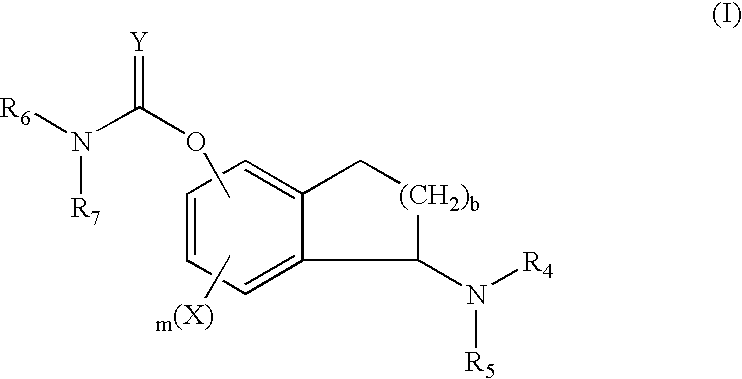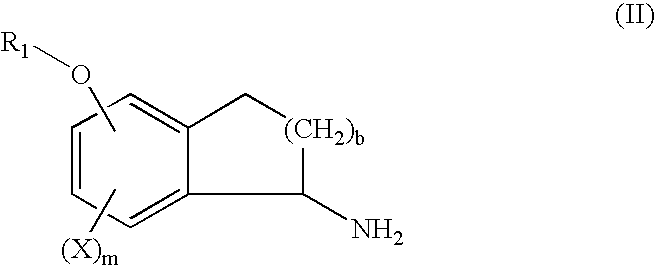Process for the synthesis of indanylamine or aminotetralin derivatives and novel intermediates
a technology of indanylamine and aminotetralin, which is applied in the preparation of carboxylic acid amides, chemistry apparatus and processes, organic chemistry, etc., can solve the problems of low yield and low reproducibility
- Summary
- Abstract
- Description
- Claims
- Application Information
AI Technical Summary
Benefits of technology
Problems solved by technology
Method used
Image
Examples
example 1
Acylation process for preparation of 6-methoxy-indan-1-one O-acetyl-oxime [3 to 1 ratio]
[0043] 6-Methoxy-1-indanone oxime (30 g, 0.169 mol.) was partially dissolved in 180 ml of THF at room temperature. Acetic anhydride (47.9 ml, 0.508 mol) was added to this solution over 15 minutes at 20° C. The reaction mixture was stirred at a temperature between 20-30° C. for 2 hours, then concentrated. A colorless liquid was obtained and solidified into a solid residue. The residue was dissolved in methylene chloride (60 ml) and was washed with water (60 ml) twice. The organic layer was separated from the aqueous layer, dried with MgSO4, filtered, and concentrated to obtain 56 g of a white solid. This product was partially dissolved in methyl tert-butyl ether (MTBE) (60 ml) which was then warmed at 55° C. MTBE (195 ml) was added again slowly to completely dissolve the product. The solution was warmed at reflux temperature for 5 minutes. The solution was cooled to room temperature (20° C.) as th...
example 2
Preparation of N-(6-methoxy-indan-1-yl)-acetamide
[0044] 6-Methoxy-1-indanone oxime (2 g) was partially dissolved in 20 ml THF. To this solution acetic anhydride (4.4 g) was added over 10 minutes at 15-20° C. The reaction mixture was stirred at 15-20° C. for 2 hours followed by the addition of PtO2 with 40% Pt (14 mg, 1.4% of metal Pt per oxime derivative) to 5 ml of the reaction mixture. The hydrogenation was carried out with a hydrogen pressure of 4 bars (400 kPa) at a temperature between 30-40° C. for 10 hours. The reaction mixture was filtered and then quenched with sodium hydroxide until a pH of about 8-9 was obtained, while maintaining the temperature below 25° C. The aqueous layer was subsequently removed and the organic layer was concentrated to obtain the product, N-(6-methoxy-1-indan-1-yl)-acetamide. The yield was 90%.
example 3
Preparation of 6-methoxy-indan-1-ylamine
[0045] 6-Methoxy-indan-1-one oxime (1 kg) was partially dissolved in 6 liters of THF. Acetic anhydride (1.73 kg) was added to the solution over 15 minutes at 20° C. The reaction mixture was stirred between 20-30° C. for 2 hours. To this reaction mixture, Pd / C 5% (0.1 kg, 0.5% of metal Pd / oxime derivative) was added. Hydrogenation was performed with a hydrogen pressure of 3 bars (300 kPa) at a temperature between 30-40° C. over 4-6 hours. The reaction mixture was filtered and concentrated under atmospheric pressure to a volume of 3 liters. The concentrate was warmed to 70° C., then 4 liters of water were added and temperature maintained at 70° C. for 1 hour. The mixture was slowly warmed in a 95° C. bath until evaporation of the solvent was complete. The mixture was cooled to 36° C., 4 liters of methylene chloride were added and the mixture was further cooled to 20° C. The mixture was quenched with an aqueous solution of 30% sodium hydroxide (...
PUM
| Property | Measurement | Unit |
|---|---|---|
| w/w | aaaaa | aaaaa |
| temperature | aaaaa | aaaaa |
| temperature | aaaaa | aaaaa |
Abstract
Description
Claims
Application Information
 Login to View More
Login to View More - R&D
- Intellectual Property
- Life Sciences
- Materials
- Tech Scout
- Unparalleled Data Quality
- Higher Quality Content
- 60% Fewer Hallucinations
Browse by: Latest US Patents, China's latest patents, Technical Efficacy Thesaurus, Application Domain, Technology Topic, Popular Technical Reports.
© 2025 PatSnap. All rights reserved.Legal|Privacy policy|Modern Slavery Act Transparency Statement|Sitemap|About US| Contact US: help@patsnap.com



